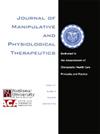Influence of Physical Characteristics of Obstacles on the Locomotor Pattern of Older Adults at Higher Risk of Falling
IF 1.4
4区 医学
Q4 HEALTH CARE SCIENCES & SERVICES
Journal of Manipulative and Physiological Therapeutics
Pub Date : 2024-07-01
DOI:10.1016/j.jmpt.2024.09.002
引用次数: 0
Abstract
Objective
This study aimed to investigate the locomotor behavior of older adults with and without a history of falls as they avoided obstacles with different physical characteristics.
Methods
Twenty-one older adults participated in this study. The group was divided into higher risk of falling (n = 10) and lower risk of falling (n = 11). The following conditions were carried out: (1) walking and avoiding a solid obstacle and (2) walking and avoiding a fragile obstacle.
Results
Older adults at higher risk of falling had worse performance during the obstacle approach phase. Both groups performed worse when avoiding the fragile obstacle than when avoiding the solid obstacle. Older adults at higher risk of falling had their feet closer when avoiding the obstacle, and both groups raised their limbs higher to avoid a fragile obstacle. Older adults at higher risk of falling were closer to obstacles after avoiding them.
Conclusion
For the participants in this study, the physical characteristics of the obstacle did not interfere with the locomotor performance of older adults during obstacle avoidance. This study found that older adults at higher risk of falls modulated their locomotor pattern before avoiding the obstacles, presenting lower velocity, shorter step length, and greater step width compared with older adults at lower risk of falling.
障碍物的物理特征对跌倒风险较高的老年人运动模式的影响
研究目的本研究旨在调查有跌倒史和无跌倒史的老年人在避开具有不同物理特征的障碍物时的运动行为:21 名老年人参与了这项研究。方法:21 名老年人参加了此次研究,他们被分为跌倒风险较高(10 人)和跌倒风险较低(11 人)两组。实验条件如下(1) 步行并避开坚固的障碍物;(2) 步行并避开易碎的障碍物:结果:跌倒风险较高的老年人在接近障碍物阶段的表现较差。两组人在避开易碎障碍物时的表现都比避开坚固障碍物时差。摔倒风险较高的老年人在避开障碍物时双脚距离较近,两组人在避开易碎障碍物时四肢都抬得较高。跌倒风险较高的老年人在避开障碍物后更靠近障碍物:对于本研究的参与者来说,障碍物的物理特征并不会干扰老年人在避开障碍物时的运动表现。本研究发现,与跌倒风险较低的老年人相比,跌倒风险较高的老年人在避开障碍物之前会调节其运动模式,表现出较低的速度、较短的步长和较大的步幅。
本文章由计算机程序翻译,如有差异,请以英文原文为准。
求助全文
约1分钟内获得全文
求助全文
来源期刊
CiteScore
3.00
自引率
7.70%
发文量
63
审稿时长
29 weeks
期刊介绍:
The Journal of Manipulative and Physiological Therapeutics (JMPT) is an international and interdisciplinary journal dedicated to the advancement of conservative health care principles and practices. The JMPT is the premier biomedical publication in the chiropractic profession and publishes peer reviewed, research articles and the Journal''s editorial board includes leading researchers from around the world.
The Journal publishes original primary research and review articles of the highest quality in relevant topic areas. The JMPT addresses practitioners and researchers needs by adding to their clinical and basic science knowledge and by informing them about relevant issues that influence health care practices.

 求助内容:
求助内容: 应助结果提醒方式:
应助结果提醒方式:


